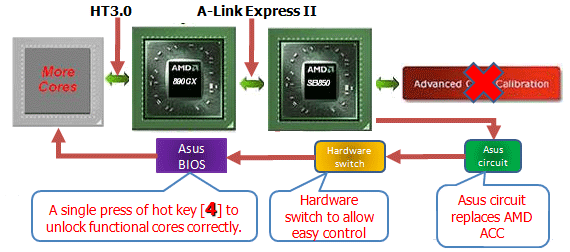How AMD Core Unlocking Works
We've spent the last couple of weeks travelling the length of Taipei, seeking answers from the three main motherboard companies: ASUS, Gigabyte and MSI, learning how exactly they've each achieved the core unlocking capacity for AMD AM3 CPUs, especially as it's been officially removed by AMD from its latest 8-series chipsets.We’ll start with a bit of background first. At the time of AM2+'s demise, AMD was losing ground (and money) hand over fist to Intel and needed any advantage it could grab. While AMD must have been concerned about the fact that core unlocking could erode the market for the company's latest Phenom II X4 CPUs and pushed the ASP (average selling price) downwards, the vast majority of consumer CPUs it sells are sub-£100 models and core unlocking helped revitalise interest in these.
With its previous SB710/SB750 Southbridge, AMD introduced a new feature called Advanced Clock Calibration. This included an "EC Firmware" function in the BIOS that could be issued a set of codes (subsequently provided by AMD to partners) and this would enable the extra cores of compatible CPUs that had previously been disabled. The EC Firmware is specific to each CPU that has a hidden core(s), so there's a list of codes need for all the CPU individually, rather than just one global setting.

In the latest SB850 southbridge AMD hid the EC Firmware function and declined to issue a new set of compatible codes, much to the dismay of motherboard manufacturers. They could either accept that it was game over for core unlocking, or call in the engineers and come up with their own ways to get it working again. They feared that without it - and facing a rejuvenated £100 Intel line-up with the excellent Core i3-530, interest in AM3 would decline.
Asus
First out the blocks with an 890 chipset board capable of CPU core unlocking was Asus' 890GX based Asus M4A89GTD Pro/USB. Clearly it took the other motherboard companies by surprise as both MSI and Gigabyte were at least a month behind. It's highly unusual for one company to have such a big, clear lead - chalk one up to Asus' secrecy there. It wasn't until recently that Asus would let us in on how it able to achieve this.
Asus engineers basically replaced the whole advanced clock calibration circuit (ACC) and then substituted in a hardware switch which issued its own EC Firmware codes for the CPUs instead. This costs a few dollars more, but Asus claims it not only gives more control to select individual cores (if there's more than one available) for the maximum unlocking success rate, but given previous experience the engineers have developed a feature to test and check if the unlocked cores even function correctly and disable bad ones automatically.
On Most Asus boards this option is available with a BIOS switch, but with its recent [Crosshair IV Formula motherboard it now has a hardware button on the board to turn it on and off, although we're unsure if it still requires the complete system reboot in the same way.

MSI MPG Velox 100R Chassis Review
October 14 2021 | 15:04









Want to comment? Please log in.